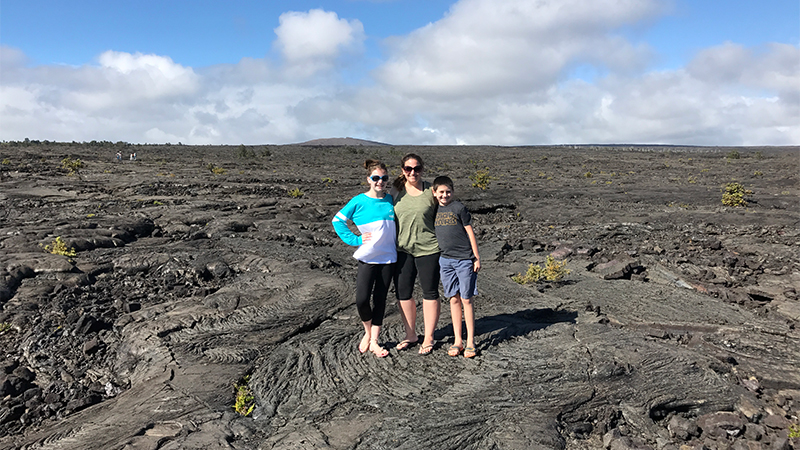
After visiting the splatter zone of Mauna Ulu on the short Mauna Ulu Crater Eruption Trail, with lava tree molds, glittering lava rocks, steam vents, and weird lava formations, we were really curious to check out Mau Loa O Mauna Ulu, which means forever growing mountain.
From the roadside pullout, you can see Mauna Ulu in one direction and the sparkling, blue Pacific Ocean in the other. For miles in all directions, the sprawling hills and cliffs are blanketed in smooth, curving, rolling, black pahoehoe lava originating from the 1969-1974 eruption of Mauna Ulu. The pahoehoe lava looks like brownie batter and in some places it has a shiny glaze that is created by an outer layer of silica or surface glass.
The lava flows in this area crossed and re-crossed Chain Of Craters Road several times throughout the duration of the five year Mauna Ulu eruption. Thankfully the road has been cleared and rebuilt so visitors can enjoy the unique beauty of Hawai’i Volcanoes National park.
A short paved trail leads to the Mau Loa O Mauna Ulu observation deck that sits at 2,959 elevation. From the observation deck, you can truly understand just how expansive the Mauna Ulu flows were and see where the lava flowed down the mountain right into the ocean. If you look down, you’ll also see cracks in the lava where small ferns and lichens have started growing.
The panoramic views from this lookout, especially on a sunny day, are incredibly breathtaking. Just be sure you’re prepared for big gusts of wind!
Know Before You Go
- Mau Loa O Mauna Ulu is located 2.7 miles from the Mauna Ulu Crater Eruption Trail, 6.4 miles from the start of Chain of Craters Road, and 9.7 miles from the Kīlauea Visitor Center on Chain Of Craters Road in Hawai’i Volcanoes National Park.
- Mau Loa means eternal or forever and Mau Loa O Mauna Ulu means the long continuous growing mountain or Forever Growing Mountain.
- There is no restroom, no shade, and no water. Be sure to bring sunscreen, a hat, and lots of water.
- The Keauhou Trail begins at the parking area and continues 6.8 to the Keauhou Camp on the coast. It is a grueling, hot hike through predominately non-native grasses to a small rocky bay where cold fresh water seeps to the surface and mixes with the ocean.







